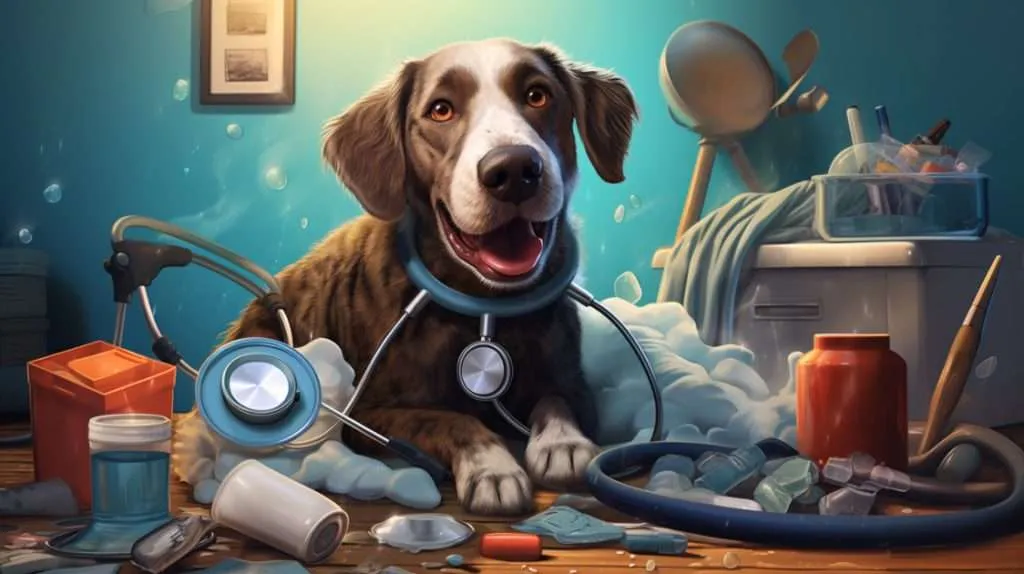Table of Contents
Is your furry friend panting excessively?
While panting is normal for dogs, excessive panting could indicate an underlying health issue. One possible cause to consider is diabetes. Just like humans, dogs can develop diabetes, a chronic condition that affects the body’s ability to regulate blood sugar levels.
Excessive panting and other symptoms such as increased thirst, frequent urination, and sudden weight loss could indicate that your dog is dealing with this metabolic disorder. However, it’s important to note that other factors can also cause excessive panting.
This article will explore the link between dog diabetes symptoms panting and other potential causes. We will also discuss managing your dog’s blood sugar levels, making dietary changes, and providing the necessary support and care for diabetic dogs.
Understanding the sign of diabetes and taking appropriate measures can help ensure your furry companion’s well-being.
Key Takeaways Of Dog Diabetes Symptoms Panting
- Excessive panting in dogs can indicate an underlying health issue, including diabetes.
- Other diabetes symptoms in dogs include increased thirst, frequent urination, and unexplained weight loss.
- Regular veterinary check-ups and diagnostic tests are important for identifying and managing diabetes in dogs.
- Maintaining a healthy weight, providing regular exercise, and feeding a balanced diet can help prevent diabetes in dogs.
Understanding Normal Panting in Dogs

Are you wondering why your dog pants so much? Well, let’s understand why panting is completely normal for dogs!
Panting is a natural way for dogs to regulate their body temperature, especially when hot or after physical activity. It’s their equivalent of sweating.
Normal panting behavior can differ from one dog to another, depending on factors such as breed, age, and overall health. For example, brachycephalic breeds like Bulldogs tend to pant more due to their shorter snouts. Other factors affecting panting include anxiety, excitement, and pain.
It’s important to observe your dog’s panting patterns and recognize what is normal for them.
Now that we’ve covered normal panting behavior let’s move on to recognizing excessive panting in dogs.
Recognizing Excessive Panting in Dogs

Excessive panting in dogs can sometimes indicate a serious health condition that needs attention. While it’s normal for dogs to pant to regulate their body temperature, excessive panting can indicate an underlying issue.
Due to their shortened airways, certain dog breeds are more prone to panting, such as brachycephalic breeds like Bulldogs and Pugs. To keep your dog cool during hot weather, provide plenty of fresh water, shade, and avoid strenuous exercise during the hottest parts of the day. You can also use cooling mats or wet towels to help them cool down.
It’s important to monitor your dog’s panting behavior and seek veterinary attention if it becomes excessive or if you notice any other concerning symptoms.
Transitioning into the next section, recognizing common symptoms of diabetes in dogs can help you take prompt action if necessary.
Common Symptom of Diabetes in Dogs

Dogs with diabetes mellitus may experience a range of symptoms, including loss of appetite, hair loss, and increased respiratory rate. Dog owners need to recognize these symptoms as they can indicate diabetes in dogs. Proper treatment and management of diabetes are crucial to ensure a happy life for dogs with this condition. Dogs with diabetes may also be at an increased risk of developing complications such as liver disease and laryngeal paralysis.
Monitoring blood pressure and providing the appropriate type of diabetes medication, such as insulin, is essential for controlling diabetes in dogs. Corn syrup can be used in emergencies to raise blood sugar levels in dogs with low blood sugar. Understanding the different types of diabetes in dogs and their associated symptoms can help dog owners provide the best care for their furry companions.
The Link Between Excessive Panting and Diabetes

Did you know that excessive dog panting can be a potential indicator of diabetes, affecting approximately one in every fifty canine pets? Panting is a crucial cooling mechanism for dogs, but it may signify an underlying health issue when it becomes excessive. One possible cause of excessive panting is dehydration, as dogs rely on panting to regulate their body temperature and maintain hydration levels. Another factor is anxiety, which can trigger rapid and heavy breathing in dogs. To illustrate the link between excessive panting and diabetes, consider the following table:
| Potential Causes of Excessive Panting | |:—:|:—:| |Dehydration|Anxiety| |Heatstroke|Heart disease| |Respiratory problems|Obesity|
Understanding the connection between excessive panting and diabetes can help you identify potential health concerns in your furry friend. Moving forward, we will explore other possible causes of excessive panting in dogs.
Other Potential Causes of Excessive Panting

One possible reason for heavy and rapid breathing in dogs is the scorching heat, which can leave them gasping for air. However, excessive panting can also indicate underlying medical conditions or behavioral factors. Considering these other potential causes is important before jumping to conclusions about your dog’s health.
Here are a few factors that could contribute to excessive panting:
- Anxiety or stress: Dogs may pant excessively when anxious or stressed.
- Pain or discomfort: Dogs may pant due to pain or discomfort caused by an injury or illness.
- Medication side effects: Certain medications can cause dogs to pant more than usual.
- Heart or respiratory problems: Dogs with heart or respiratory issues may pant excessively as their bodies try to compensate for the lack of oxygen.
Understanding these potential causes can help determine if your dog’s panting results from a more serious underlying condition. Regular veterinary check-ups are crucial to ensure your dog’s overall health and well-being.
The Importance of Regular Veterinary Check-ups
Make sure to prioritize regular veterinary check-ups, as they’re vital for ensuring your furry friend’s overall health and well-being and could potentially save them from serious underlying conditions. Regular vet visits allow your veterinarian to monitor your dog’s health and catch any potential issues early on. Early detection is key in managing and treating many health conditions, including diabetes.
During these check-ups, your vet will perform a thorough physical examination, ask about any changes in behavior or appetite, and may recommend diagnostic tests if necessary. These tests can help identify whether your dog has diabetes or other health concerns.
You can give your dog the best chance of a long, healthy life by staying proactive with regular vet visits.
Transitioning into the next section, let’s explore the diagnostic tests for diabetes in dogs.
Diagnostic Tests for Diabetes in Dogs
Regular veterinary check-ups are essential for maintaining your dog’s health and catching potential issues early on. Regarding diabetes in dogs, early intervention is crucial in managing the condition effectively. Diagnostic tests are vital in identifying diabetes, allowing for prompt treatment. These tests include blood glucose monitoring, urine analysis, and glycated hemoglobin testing. By utilizing these diagnostic tools, veterinarians can accurately diagnose diabetes in dogs and determine the appropriate course of action. Early detection enables timely intervention, significantly improving your dog’s quality of life and preventing potential complications. Sometimes, pet parents think their dog is peeing more because she’s drinking more, but it is the other way around.
To evoke an emotional response, here is a table illustrating the potential consequences of undiagnosed and untreated diabetes in dogs:
| Consequence | Impact | Emotional Response |
|---|---|---|
| Chronic fatigue | Limited energy and decreased activity | Concern for your dog’s well-being |
| Frequent urination | Discomfort and inconvenience | Empathy towards your dog’s discomfort |
| Weight loss and muscle wasting | Visible physical decline | Sadness over your dog’s declining health |
Understanding the importance of diagnostic tests and their ability to facilitate early intervention is crucial in managing canine diabetes effectively. These tests provide the necessary information for veterinarians to develop an appropriate treatment plan. So, let’s explore the available treatment options for canine diabetes.
Treatment Options for Canine Diabetes
To effectively manage canine diabetes, you’ll need to explore the various treatment options available. Along with insulin therapy, there are other treatment approaches that can help prevent complications and improve your diabetic dog’s quality of life.
One such approach is canine diabetes prevention. It involves making dietary changes, such as feeding your dog a balanced and controlled diet to regulate their blood sugar levels. Regular exercise is also important as it helps to maintain a healthy weight and improves insulin sensitivity.
When treating a diabetic dog with panting symptoms, it is important to address various factors. Firstly, monitoring the dog’s blood pressure is crucial to ensure it remains within a healthy range. Additionally, observing the dog’s appetite is essential as it can vary between normal and poor. If the dog experiences a poor appetite rather than normal appetite , it may be necessary to adjust their diet or consult a veterinarian for further guidance.
Excessive urination and extreme thirst are common symptoms in diabetic dogs, so providing access to fresh, cold water at all times is important to prevent dehydration. Diabetic dogs may also exhibit a lack of energy, which can be addressed by ensuring they receive regular exercise and a balanced diet. It is crucial to pay attention to the dog’s response to discomfort and seek veterinary advice if necessary.
Daily insulin injections are typically required for diabetic dogs, and it is crucial to administer them as prescribed. Lastly, understanding the role of blood vessels in diabetes management is vital, as they play a significant role in regulating blood sugar levels. Overall, a comprehensive approach that includes monitoring blood pressure, managing appetite, addressing excessive urination and extreme thirst, providing daily insulin injections, and ensuring the dog’s response to discomfort is addressed will help effectively treat a diabetic dog with panting symptoms.
Transitioning into the subsequent section about managing your dog’s blood sugar levels, it’s crucial to establish a comprehensive care plan to ensure your furry friend stays healthy and happy.
Managing Your Dog’s Blood Sugar Levels
One effective way to manage your canine companion’s blood sugar levels is by monitoring their daily food intake. This involves providing them with a balanced diet low in carbohydrates and high in protein. Additionally, managing exercise is crucial in regulating blood sugar levels. Regular physical activity helps your dog utilize glucose more efficiently and can improve insulin sensitivity.
Another important aspect of managing blood sugar levels is insulin therapy. Your veterinarian may prescribe insulin injections that must be administered at specific times throughout the day. To help you better understand the importance of managing your dog’s blood sugar levels, here is a table outlining the recommended daily food intake, exercise duration, and insulin dosage based on your dog’s weight and condition:
| Weight Range (lbs) | Daily Food Intake (cups) | Exercise Duration (minutes) | Insulin Dosage (units) |
|---|---|---|---|
| 10-25 | 0.5-1 | 15-30 | 1-2 |
| 26-50 | 1-2 | 30-60 | 2-4 |
| 51-75 | 2-3 | 60-90 | 4-6 |
| 76+ | 3-4 | 90+ | 6+ |
By closely monitoring your dog’s food intake, exercise, and insulin therapy, you can effectively manage their blood sugar levels and ensure their overall well-being. Transitioning into the subsequent section about ‘dietary changes for diabetic dogs,’ it is important to consider additional steps that can be taken to support your dog’s health.
Dietary Changes for Diabetic Dogs
Making dietary changes is crucial for diabetic dogs to manage their condition and improve their overall health effectively.
Here are three key dietary considerations for diabetic dogs:
- Canine insulin therapy: Diabetic dogs require insulin injections to control their blood sugar levels. It’s important to coordinate the timing of their meals with their insulin injections to ensure optimal blood sugar control.
- Carbohydrate control for dogs: Reducing the amount of carbohydrates in your dog’s diet can help regulate their blood sugar levels. Opt for low-glycemic index carbohydrates like sweet potatoes or whole grains to provide sustained energy without causing spikes in blood sugar.
- Portion control: Monitoring and controlling portion sizes is crucial to maintaining stable blood sugar levels in diabetic dogs. Feeding smaller, more frequent meals throughout the day can help prevent dramatic fluctuations in blood sugar.
By making these dietary changes, you can effectively manage your dog’s diabetes and improve their quality of life.
Now, let’s explore how to monitor and prevent complications associated with diabetes in dogs without writing ‘step.’
Monitoring and Preventing Complications
Watch for signs of fatigue or excessive thirst, which could indicate potential complications in your furry companion. As a responsible dog owner, it’s crucial to monitor and prevent diabetic complications in your dog.
One key aspect is regularly monitoring their glucose levels. This can be done through blood tests and observing their behavior. If you notice any abnormalities, consult your veterinarian immediately.
Additionally, maintaining a consistent and appropriate diet is essential in preventing complications. Ensure your dog receives a balanced diet with the right amount of carbohydrates and proteins. It’s also crucial to exercise regularly and keep their weight in check.
By taking these preventive measures, you can provide the best support and care for your diabetic dog. This will be further discussed in the subsequent section about supporting and caring for diabetic dogs.
Providing Support and Care for Diabetic Dogs
To properly support and care for a diabetic dog, it’s important to establish a routine that includes regular exercise and a balanced diet. Exercise helps regulate blood sugar levels and maintain a healthy weight, while a balanced diet ensures that your dog receives the necessary nutrients without causing spikes in blood sugar.
Additionally, following the prescribed insulin therapy for your dog is crucial. Insulin injections help regulate blood sugar levels and prevent complications associated with diabetes.
It’s also helpful to join support groups for diabetic dog owners. These groups provide a supportive community where you can share experiences, learn from others, and receive valuable tips and advice.
Remember, with proper care and support, your diabetic dog can live a happy and fulfilling life.
Frequently Asked Questions
Can excessive panting in dogs indicate any other health issues besides diabetes?
Excessive panting in dogs can indicate other health issues besides diabetes. To differentiate between normal and excessive panting, look for accompanying symptoms like coughing, wheezing, lethargy, or difficulty breathing. Consult a veterinarian for a proper diagnosis.
How can I differentiate between normal panting and excessive panting in my dog?
Differentiating normal vs. excessive panting in dogs is like distinguishing a gentle breeze from a hurricane. Normal panting occurs after exercise or in hot weather, while excessive panting may indicate pain, stress, or underlying health issues.
Are certain dog breeds more prone to developing diabetes and excessive panting?
Certain dog breeds are more prone to developing diabetes and experiencing excessive panting. This breed predisposition is due to genetic factors and can be influenced by factors such as obesity and age.
Can excessive panting in dogs be treated without medication?
Excessive panting in dogs can be treated without medication through natural remedies. Techniques such as providing a cool and comfortable environment, using water therapy, and practicing relaxation exercises can help alleviate panting and promote overall well-being.
Are there any specific dietary restrictions for diabetic dogs with excessive panting?
Dietary management is crucial in managing diabetes in dogs with excessive panting. Consult a veterinarian for a specialized diet plan that includes proper nutrition, controlled carbohydrates, and a regular feeding schedule. Alternative treatments may also be recommended.
Conclusion
In conclusion, it is important to be aware of the various symptoms and complications associated with dog diabetes, such as heavy panting, loss of appetite, muscle weakness, and hair loss. Additionally, monitoring blood glucose levels and respiratory rate can help detect signs of diabetes in dogs. Proper treatment and management of diabetes can prevent complications such as urinary tract infections, kidney diseases, heart failure, and liver disease. By understanding the different types of diabetes, like diabetes mellitus, and providing dogs with diabetes mellitus with the necessary care and attention, we can ensure that they lead a happy and healthy life.
Reader Advisory: This article, aimed at informational purposes, does not replace professional veterinary advice. While we aim for accuracy, we make no guarantees regarding the completeness or reliability of our content. Always consult a veterinarian before altering your dog’s diet or nutrition.




